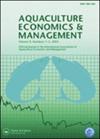Economic tradeoffs and risk between traditional bottom and container culture of oysters on Maryland farms
IF 3.8
2区 经济学
Q1 AGRICULTURAL ECONOMICS & POLICY
引用次数: 8
Abstract
Abstract Availability of new oyster production methods offers a variety of choices for oyster farmers that include the overall business model, marketing strategy, scale of production, and the production method. Cost structures and relative profitability vary across production methods, scales, and business models. Maryland oyster farms were used as the basis for an assessment of the relative economic tradeoffs among traditional and newer, more intensive, production methods based on farm-level data. Oyster farmers in Maryland were interviewed in 2018 and 2019 to collect data from farm records on expenditures, prices, investment in equipment and facilities, and common problems. Production method/scale categories identified included annual production levels of ≤200 bushels and >200 bushels for traditional bottom culture and ≤6,000 and >6,000 boxes (100-count) for container culture. Cost structures were identified for each category, and accounting and economic net returns (profit) calculated for each (in $/bushel for traditional bottom culture and $/box for container culture). Stochastic dominance for profitability was assessed across the four farming categories. Cost structures differed substantially across the four categories, with fuel the greatest expense for traditional bottom culture farms and labor, followed by marketing costs, the greatest expenses for container culture farms. All categories were profitable based on accounting net returns, but only the large-scale farms for each production method were profitable in terms of economic net returns. The most profitable category was the large-scale container culture category followed by the large-scale bottom culture category, but the larger traditional bottom culture category was the least risky (by first-order stochastic dominance). Risk was substantially greater for the larger container culture category and for the smaller bottom culture category. Continued Extension support is needed to provide assistance with comprehensive business financial planning and risk mitigation (including efforts to reduce yield variability), especially for startup farms seeking to grow to provide full-time salaries for owners/operators.马里兰州养殖场传统底养殖和容器养殖牡蛎之间的经济权衡和风险
牡蛎生产新方法的出现为牡蛎养殖者提供了多种选择,包括整体商业模式、营销策略、生产规模和生产方法。成本结构和相对盈利能力因生产方法、规模和商业模式而异。以马里兰州牡蛎养殖场为基础,根据养殖场层面的数据,对传统和更新、更集约化的生产方式之间的相对经济权衡进行了评估。马里兰州的牡蛎养殖户在2018年和2019年接受了采访,从农场记录中收集有关支出、价格、设备和设施投资以及常见问题的数据。所确定的生产方法/规模类别包括:传统底部养殖的年产量水平≤200蒲式耳和200蒲式耳,容器养殖的年产量水平≤6000和6000箱(100计数)。确定了每个类别的成本结构,并计算了每个类别的会计和经济净回报(利润)(传统底部文化以美元/蒲式耳计算,容器文化以美元/箱计算)。对四种农业类别的盈利能力进行了随机优势评估。四类养殖场的成本结构差异很大,传统底层养殖场的最大成本是燃料和劳动力,其次是营销成本,集装箱养殖场的最大成本是营销成本。从会计净收益来看,所有类别都是盈利的,但从经济净收益来看,只有每种生产方式的大型农场是盈利的。最赚钱的类别是大型容器文化类别,其次是大型底部文化类别,但较大的传统底部文化类别风险最小(通过一阶随机优势)。对于较大的容器培养类别和较小的底部培养类别,风险要大得多。需要持续的推广支持,以提供全面的业务财务规划和风险缓解(包括努力减少产量变化)方面的援助,特别是对于寻求发展以为业主/经营者提供全职工资的初创农场。
本文章由计算机程序翻译,如有差异,请以英文原文为准。
求助全文
约1分钟内获得全文
求助全文
来源期刊

Aquaculture Economics & Management
FISHERIES-
CiteScore
7.30
自引率
17.90%
发文量
21
期刊介绍:
Aquaculture Economics and Management is a peer-reviewed, international journal which aims to encourage the application of economic analysis to the management, modeling, and planning of aquaculture in public and private sectors. The journal publishes original, high quality papers related to all aspects of aquaculture economics and management including aquaculture production and farm management, innovation and technology adoption, processing and distribution, marketing, consumer behavior and pricing, international trade, policy analysis, and the role of aquaculture in food security, livelihoods, and environmental management. Papers are peer reviewed and evaluated for their scientific merits and contributions.
 求助内容:
求助内容: 应助结果提醒方式:
应助结果提醒方式:


